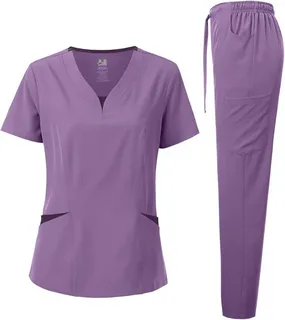Nursing professionals spend long hours on their feet, moving between patients, handling emergencies, and navigating emotionally demanding situations. Amid this fast-paced environment, one constant remains: the need for reliable, comfortable, and professional attire. Nursing scrub tops and pants are more than just uniforms—they are vital tools that support efficiency, hygiene, and the confidence to perform under pressure.
This article provides an authoritative guide to nursing scrubs, focusing on their function, features, and why choosing the right set matters for healthcare professionals.
What Are Nursing Scrubs?
Nursing scrubs top and pants are specially designed garments worn by healthcare workers in medical settings. They typically consist of a V-neck top and drawstring or elastic-waist pants made from durable, breathable fabric. Originally designed for use in surgical environments, scrubs are now a universal standard across hospitals, clinics, aged care facilities, and private practices.
Purpose of Scrubs in Healthcare
Scrubs serve several critical purposes:
- Hygiene: Made from antimicrobial or easy-to-clean materials, scrubs help prevent cross-contamination and spread of infections.
- Professionalism: Uniforms help establish trust between patients and providers by signifying authority and expertise.
- Identification: Color-coded or branded scrubs help distinguish between roles and departments in medical facilities.
- Functionality: Features such as multiple pockets and flexible seams allow nurses to carry tools and move freely.
Material Matters: What to Look For in Scrub Fabric
The comfort and performance of nursing scrubs heavily depend on fabric composition. Ideal materials should offer:
- Breathability: Cotton or cotton-blend scrubs allow air circulation, keeping the wearer cool.
- Durability: Polyester blends or spandex add resistance to wear, washing, and stretching.
- Flexibility: Stretch fabric (usually with 2–5% spandex) supports movement during long shifts.
- Moisture-wicking: Advanced synthetic fabrics draw sweat away, maintaining dryness.
- Easy care: Wrinkle-resistant, fade-proof, and machine-washable options save time and maintain a professional appearance.
Common Fabric Blends:
- 65% Polyester / 35% Cotton: Cost-effective and durable; may lack softness.
- 55% Cotton / 42% Polyester / 3% Spandex: Ideal blend of comfort, stretch, and ease of maintenance.
Key Features of Scrub Tops
- Neckline Design
- V-neck: The most common style, offers a clean and professional appearance.
- Mock wrap: Provides a feminine touch, often with additional coverage.
- Pockets
- Chest or lower front pockets for pens, ID badges, gloves, and personal items.
- Side Vents or Slits
- Increases mobility and reduces garment strain during movement.
- Fit Options
- Classic fit: Relaxed, unisex cut suitable for all body types.
- Modern fit: More tailored, designed to contour the body while maintaining modesty.
- Additional Features
- Badge loops
- Hidden zippers for modesty or maternity use
- Antimicrobial or fluid-repellent finishes
Key Features of Scrub Pants
- Waistbands
- Drawstring: Adjustable and cost-effective.
- Elastic: Quick to pull on and comfortable.
- Yoga-style: Offers maximum comfort and modern appearance.
- Leg Styles
- Straight-leg: Traditional, professional look.
- Boot-cut: Slight flare at the hem, pairs well with clogs.
- Jogger: Tapered with elastic cuffs—popular for comfort and style.
- Pockets
- Side and cargo pockets provide storage for essential tools.
- Zippered or patch pockets keep personal items secure.
Best Practices for Choosing Nursing Scrubs
- Consider Your Workplace Dress Code
Many hospitals enforce color-coded scrubs or specific uniform styles to maintain uniformity and easy role identification. Always check with your employer before purchasing. - Prioritize Fit and Comfort
Nurses often work 10–12 hour shifts. Scrubs that pinch, restrict movement, or lack breathability can hinder performance and lead to physical discomfort. - Check for Quality Stitching
Double-stitched seams and reinforced stress points add to the garment’s longevity, especially for professionals who wash their scrubs frequently. - Test for Functionality
Try squatting, reaching, and bending while trying on scrubs to ensure flexibility and full range of motion. - Opt for Neutral or Approved Colors
Navy, grey, and ceil blue are popular for their clean, professional look and stain-hiding qualities.
Benefits of Wearing High-Quality Scrubs
- Enhanced Performance: Comfortable scrubs reduce distractions, allowing nurses to focus on patient care.
- Improved Hygiene: Proper materials resist bacteria and bodily fluids, contributing to a safer healthcare environment.
- Brand Representation: Uniform branding reflects your facility’s commitment to professionalism and trust.
- Psychological Boost: A well-fitting, stylish scrub set can positively impact self-image and morale.
Sustainability in Scrubs: A Growing Trend
With increased awareness around environmental responsibility, many brands are now producing eco-friendly Nursing scrubs Melbourne. These scrubs are made from recycled polyester, organic cotton, or biodegradable materials and often come with certifications like OEKO-TEX® or Global Organic Textile Standard (GOTS).
Top Sustainable Brands (as of 2024–2025):
- FIGS® (Recycled fabric options)
- Care+Wear® (Partnered with designers and hospitals for inclusive, eco-conscious uniforms)
- Jaanuu® (EcoFlex™ and antimicrobial technology)
Caring for Your Scrubs
To maintain quality and hygiene, follow these laundering tips:
- Wash separately in warm water with antibacterial detergent.
- Turn inside out to preserve color.
- Avoid fabric softeners as they may reduce antimicrobial properties.
- Tumble dry on low or hang dry to extend fabric life.
Expert Tips from Healthcare Professionals
“I always recommend buying at least three sets of high-quality scrubs. Rotate them regularly and keep one spare at work just in case.”
— Jane Morales, RN, Sydney General Hospital
“Look for scrubs with functional pockets and a stretchy waistband—especially if you’re working in ER or critical care. You don’t want to be adjusting your clothes in the middle of a code.”
— Dr. Samuel Price, Clinical Director, Brisbane
Conclusion
Nursing scrub tops and pants are more than just uniforms—they’re a symbol of professionalism, hygiene, and pride in caregiving. With the right material, fit, and features, scrubs can support nurses and healthcare staff in their physically and emotionally demanding roles. Whether you’re a nursing student or a seasoned RN, investing in the right set of scrubs is an investment in your daily comfort, performance, and professional image.





